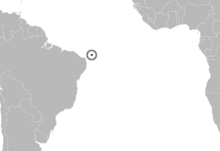Noronhomys
| Noronhomys | |
|---|---|
| Scientific classification | |
| Kingdom: | Animalia |
| Phylum: | Chordata |
| Class: | Mammalia |
| Order: | Rodentia |
| Family: | Cricetidae |
| Subfamily: | Sigmodontinae |
| Tribe: | Oryzomyini |
| Genus: |
Noronhomys Carleton and Olson, 1999 |
| Species: | N. vespuccii |
| Binomial name | |
|
Noronhomys vespuccii Carleton and Olson, 1999 |
|
 |
|
| Location of Fernando de Noronha, the island group to which Noronhomys was endemic. | |
Noronhomys vespuccii, also known as Vespucci's rodent, is an extinct rat species from the islands of Fernando de Noronha off northeastern Brazil. Italian explorer Amerigo Vespucci may have seen it on a visit to Fernando de Noronha in 1503, but it subsequently became extinct, perhaps because of the exotic rats and mice introduced by the first explorers of the island. Numerous but fragmentary fossil remains of the animal, of uncertain but probably Holocene age, were discovered in 1973 and described in 1999.
Noronhomys vespuccii was a fairly large rodent, larger than the black rat (Rattus rattus). A member of the family Cricetidae and subfamily Sigmodontinae, it shares several distinctive characters with Holochilus and related genera within the tribe Oryzomyini, including high-crowned molars with simplified crown features and the presence of several ridges on the skull which help anchor the chewing muscles. Although a suite of traits suggest that Holochilus is its closest relative, it is distinctive in many ways and is therefore classified in a separate genus, Noronhomys. Its close relatives, including Holochilus and Lundomys, are adapted to a semiaquatic lifestyle, spending much of their time in the water, but features of the Noronhomys bones suggest that it lost its semiaquatic lifestyle after arrival at its remote island.
Italian explorer Amerigo Vespucci may have seen this animal on his fourth voyage, which took him to Brazil; the Lettera di Amerigo Vespucci delle Isole Nuovamente in Quattro Suoi Viaggi recorded that he visited an island just south of the equator on August 10, 1503. On this island, identified as Fernando de Noronha, he saw "very big rats and lizards with two tails, and some snakes". The Lettera purports to be an account of Vespucci's voyages, but it is unlikely that he produced it himself and, additionally, his fourth voyage may never have actually taken place. The biological details given in the Lettera's account of Fernando de Noronha agree with what is known of the natural history of the island, lending weight to the view that it derives from an actual visit, whether by Vespucci himself or by another explorer. The lizard is probably Trachylepis atlantica and the record of snakes most likely refers to Amphisbaena ridleyi, which is actually an amphisbaenian instead of a snake.
...
Wikipedia

